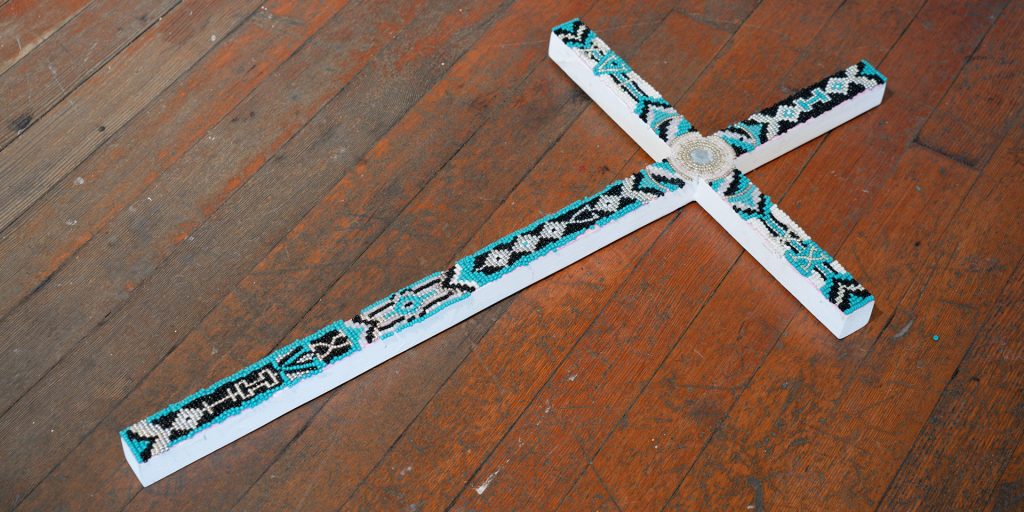MALA·FIDES is the latin origin of the phrase “bad faith”. In her new exhibition at the Frank Ratchye Project Space, McDaniel interprets this as malicious deceit as well as self-deception. Her autobiographical installation aims to draw connections between systemic and domestic forms of oppression. Specifically, McDaniel is concerned with those who commit acts of violence in the name of a higher law.
During my time sitting with this installation, I was taken aback by a familiar feeling that came across me as I encountered McDaniel’s five white crosses arranged on the wall. I was reminded of the times I would sit in a dimly lit church with my family with a large cross looming above fellow parishioners. McDaniel’s work made me reflect on my own experiences with assimilation and coming to terms with my own identity as a Filipina-American. I hope you enjoy learning more about McDaniel’s beautifully thoughtful work which will be on view in the Frank Ratchye Project Space from August 23 – September 18.
– Jess Punzalan, Root Division Exhibitions Fellow
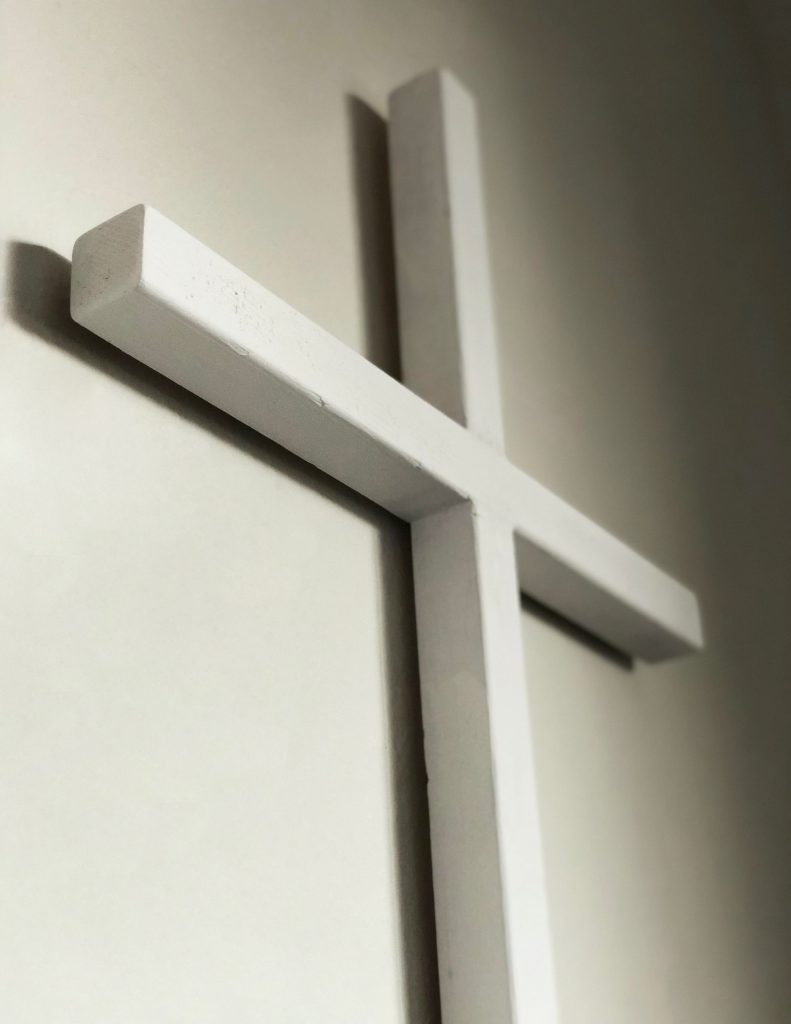
Jessica Punzalan Thanks for joining me today, Alicia! To start off, can you tell me a little bit about the online project that you and your partner founded: Virtual Gallery Online?
Alicia McDaniel Thanks for asking about that! Back in December I finished a collaboration with Root Division artist alum Melissa Wang. We had never met in person since we met solely on Zoom. Together, we decided to connect to our community by passing on this sketchbook to other Root Division artists.
Eventually, we filled the sketchbook, along with five other artists total. Melissa and I really wanted a way to exhibit this work —we wanted people to see it. My partner, Sam, is very “techie.” She’s really great with coding and she was able to set up a domain and a website for us. Sam and I decided to create a virtual project space for artists to exhibit their work, who might not have had such opportunities because of the pandemic.
JP That’s amazing. I think it also speaks a bit to how being in this virtual space has been kind of a double edged sword, because on one end, you have an opportunity to reach more people, but on the other hand, it’s a bit of a bummer to only be able to interact with people through a screen. I think that what you, Melissa, and Sam did is really amazing.
Moving on to the next question, what drives your practice? And I know that you’ve explored different mediums and types of installations, but what attracts you to the specific things that you decide to work with?
AM Oh, that’s a great question. So with a lot of the work I have made, the one consistent factor is that it’s all autobiographical in some sort of way. In the past, I had explored my lived experiences as a white-passing person of color and being mixed race and sort of trying to understand where my place in the world is, and just understanding my identity. I often compare and contrast the privilege that I have, and compare those experiences to those of my really close loved ones, who don’t pass for white. I critique larger, systemic forms of oppression for such reasons. So, I often reflect upon my experiences and the experiences of my family. That’s what really drives my practice.
JP Jumping back into your work in the Frank-Ratchye Project Space, how did you encounter the namesake of this installation and what was it like for you to come up with your interpretation of the phrase? I think your interpretation is really interesting.
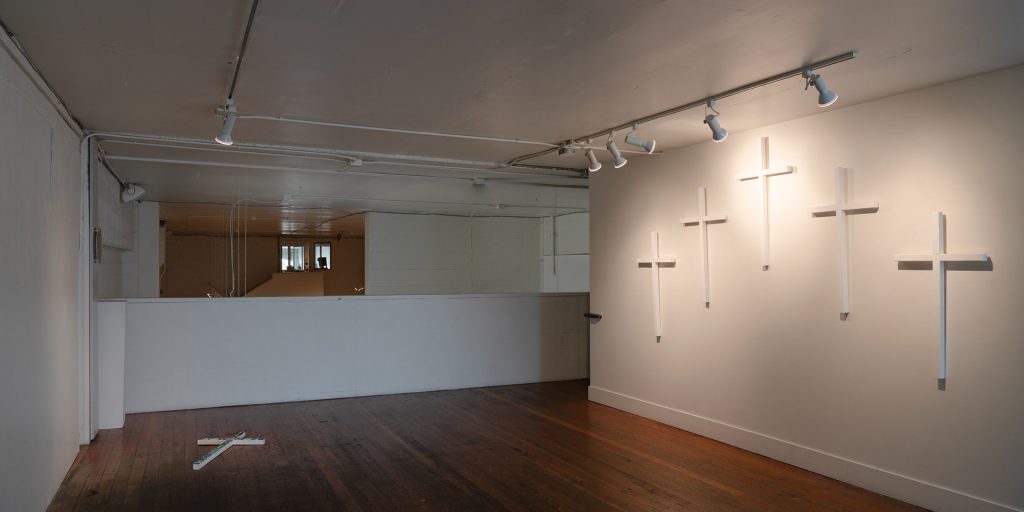
Alicia McDaniel, MALA•FIDES, 2021, Wood, adhesive, glass seed beads, Dimensions Variable
AM So it was actually Sam and I brainstorming, because the idea came to me and she helped me understand what I was trying to talk about. But, you know, titles are always very tricky. “Mala fides”, the title of the exhibition, is the Latin origin of the phrase “bad faith”. In this context, I’m thinking of “bad faith” in two instances.
Firstly, my ancestors are Indigenous Peoples and I thought about the Conquistadors who forced their religion and their viewpoints on my ancestors and the trickle down effect as to why a lot of my relatives were, sadly, self loathing and forced to assimilate and forced to get rid of their culture and customs and how that has shaped their identities and my identity, being so far down the family tree.
Secondly, I was thinking about specific generational consequences from that form of oppression. I was also thinking about someone who’s very close to me — he was a very violent person, and I grew up around him and witnessed how he would oppress another relative of mine. He would justify a lot of his actions as being natural, or kind of like, the only person who needs to forgive me is God, you know — weaponizing his faith as a reason to keep hurting and oppressing other people. I’m not trying to say there’s a direct correlation between colonialism and domestic abuse, but I think in my family’s experience, there is some sort of linking connection, because, sadly, I think a lot of the tactics of both the oppressive forces are very similar. I’m interested in exploring that more and it’s something very new to my work. So, I appreciate you asking me about that.
JP I thought your installation was extremely thoughtful. Having a similar background as a Filipina-American and growing up in the Catholic church, your piece gave me a chance to reflect on my own ancestor’s journey and similar forced assimilation.
Moving on, you have more examples of your amazing beadwork in some of your past pieces like Genizaros and Reapproachment. Can you tell me about what led you to this medium?
AM Genizaros was the first time I got into working with glass seed beads as a material. I was thinking a lot about cross cultural exchange from being a mixed race person.
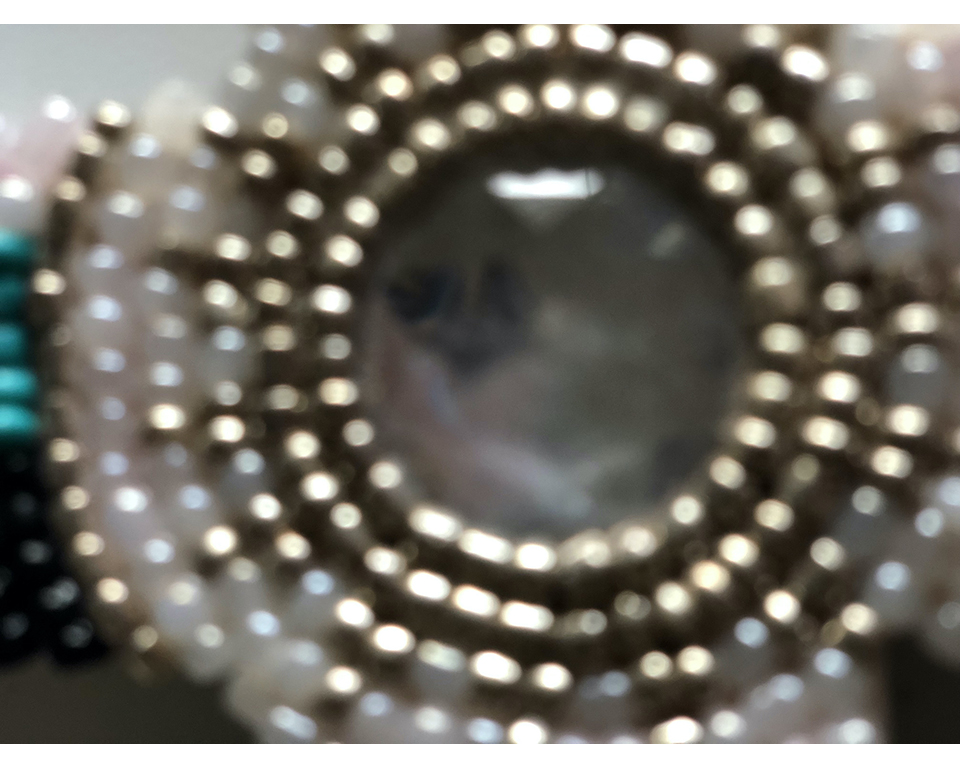
Also, I was collaborating with my mom, to sort of finish the deadline. It became a very meditative and healing experience for both of us. I think it really brought us closer together. And it was a great opportunity for both of us to sort of reconnect with something we kind of lost. It’s funny because I had a close friend of mine who also has a similar background to me, and he’s just like, “Why don’t you hand sew the beads onto a piece of fabric the traditional way instead of individually gluing them?” But you know, I’m thinking about kind of the uncanny and sort of the horror associated [with this process and diasporic] experiences — it is strange, it is a little off, and it’s not truly authentic. I think especially as someone who passes for white, my authenticity is always questioned and challenged. Sometimes I feel like I have to prove myself and being someone who’s very assimilated, how do I do that? Really, I don’t have to prove anything to anybody. That’s interesting to me. So, that kind of stemmed from that.
[Genizaros] is a reference to a different tribe that my mom had just begun doing some research on and discovered we have some roots and connections to. It was a very new thing for me at the time. I was just kind of critiquing how disconnected we are and how we’re trying to reconnect through these therapeutic, very meticulous processes and craft.
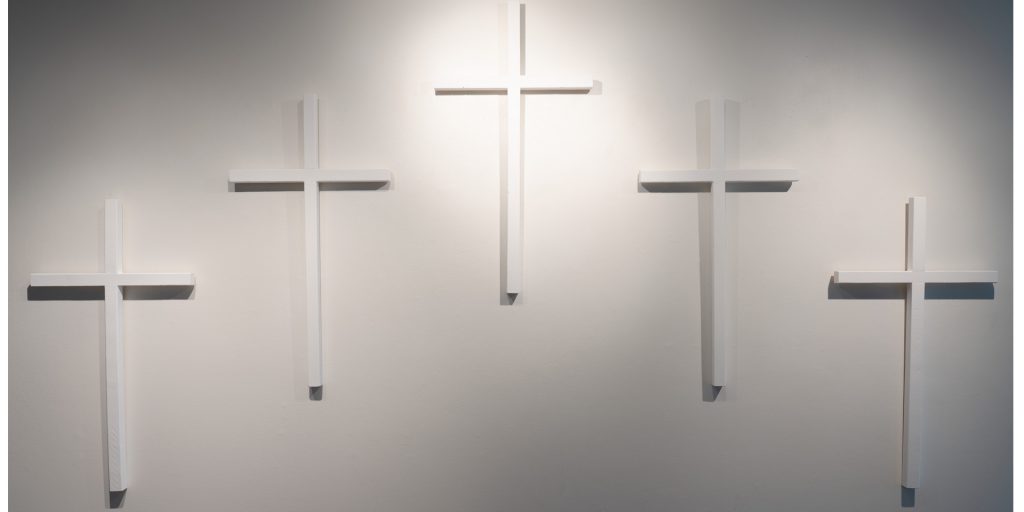
JP So I told you a bit about what I walked away with from MALA•FIDES, but what do you want viewers to take away after encountering your installation?
AM Oh, that’s a great question. I want viewers to just ask questions, you know. I put some Roman numerals and symbols on the cross because I really wanted viewers to slow down and pay attention. And there is an intention behind those images, symbols, and numbers. I really wanted viewers to really stick with the work and really question its existence.
I didn’t want to delicately place the cross that was beaded on the ground or hang it because I really wanted to mirror the violence I had previously mentioned. And I think that a lot of oppressed individuals or those who are victimized — their voices are often suppressed and silenced. They’re often thrown into the corner, quite literally. I wanted viewers to kind of take the time with the work and investigate that for themselves and kind of maybe draw their own connections, such as you said you did to the work.
JP Your work definitely got my brain going during the time I spent with it. I know your time with Root Division has come to an end and you’ve been with the organization at these different levels and seen it through different perspectives. So, how has your time with the organization affected you as an artist?
AM I love this question. Thank you for asking because I love Root Division. I think [the organization] has really helped me grow. Professionally and very personally. This was the first time I felt really connected to other artists, inside and out. And being one of the previous Exhibitions Fellow and working with other artists — it’s a very special treat, because we get to see a really intimate, firsthand look at what people are making and what they’re thinking about, and how they’re experiencing the art world around them, and sort of making these connections. I made a lot of great friends that I think I’ll stay talking to after this for many years, and a lot of collaboration has come from Root Division. [The artists] are just super generous and super thought provoking. They’re awesome! I don’t think it will be the last time I’ll be working with Root Division. I think something’s always gonna bring me back. It’s definitely like a second home to me.
JP Congratulations again, on your show! It’s such a pleasure to get to speak with you and see your art firsthand.

